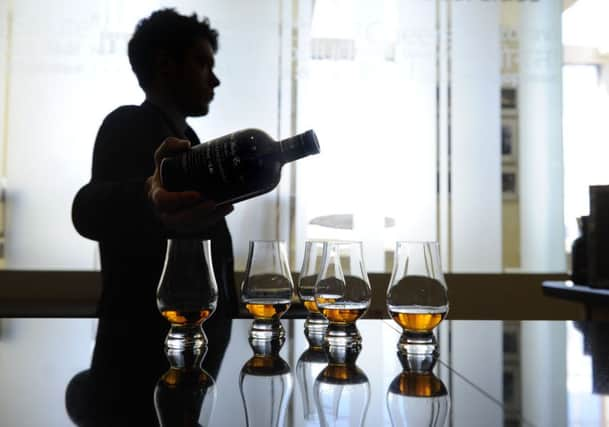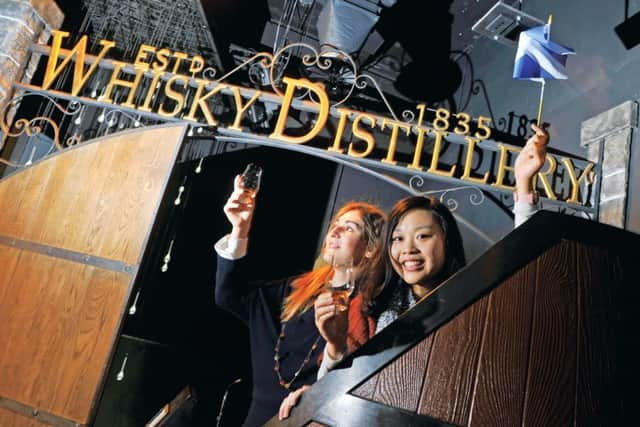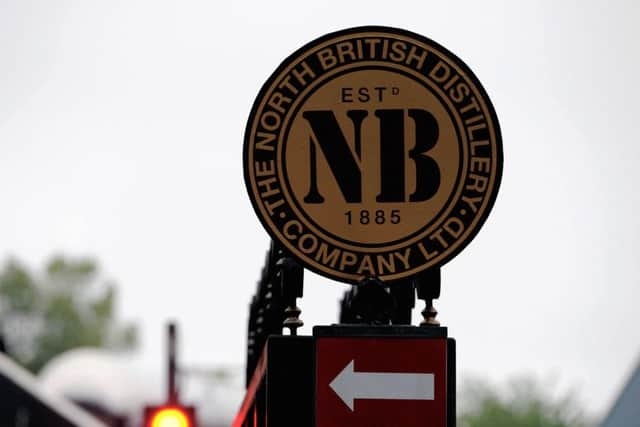Capital is distilling hot spot with resurgence of craft producers


The city may not have a concentration of producers to rival the “malt whisky country” of Speyside but that’s not to say the spirit hasn’t had an important part to play in Edinburgh’s past and present.
Today Leith’s bonded warehouses have been converted into flats and offices, an odour control tower is suppressing the smell from North British and the last single malt distillery – Glen Sciennes – is long gone, having closed its doors in 1925.
Advertisement
Hide AdAdvertisement
Hide AdCertainly a lot has changed in Edinburgh’s whisky industry but between Glenkinchie in East Lothian, plans progressing for the new Holyrood Park Distillery and the ever-expanding capacity of the vast grain distillery beside Tynecastle Stadium, there is life in it yet.


Rather than adopting a distinctive characteristic akin to Islay’s peaty malts and Speyside’s grassier tones and sherried notes, Edinburgh has made a name for itself in the blended whisky market.
The Spencerfield Spirit Company, which was bought by Ian MacLeod Distillers in September, distills gin at its Rutland Place premises but it’s also the name behind the Sheep Dip, Pig’s Nose and Feathery whisky blends.
Now run as a joint venture between Diageo and Edrington Group, almost the entire production of grain spirit from North British is sold for blending purposes.
Advertisement
Hide AdAdvertisement
Hide AdFounded in 1885 by a group of independent whisky blenders which included Andrew Usher – now best known for funding the Usher Hall – and John Crabbie of the Leith-born concoction Crabbie’s Ginger Ale, North British is Edinburgh’s last remaining active distillery. Around 170 people are employed across its Gorgie distillery and warehouse at Muirhall in West Lothian.


Some of the original buildings still stand in what is now a heavily populated area of the city but the address on Wheatfield Road harks back to a time when the site was on the outskirts of the Capital and offered the ideal location for grain distilling.
“There are three things I would say were important about the location of the distillery,” says managing director Alan Kilpatrick.
“Firstly the source of the water which comes from the Pentland Hills [via the Union Canal] and also being well served by the railway at the time was key.
Advertisement
Hide AdAdvertisement
Hide Ad“In the early days it would have been outside Edinburgh and surrounded by fields.”


The biggest thing that has changed is capacity, which is now approximately 20 times what was made in the distillery’s first year.
“It took over 100 years to produce the first 1.5 billion litres and we reached 2bn ten years later in 2008,” says Kilpatrick.
“A further seven years after that, in 2015, we had added another half a billion bringing it to 2.5bn.”
Advertisement
Hide AdAdvertisement
Hide AdThe spirit distilled at North British is used in most of the best-known blends including Famous Grouse and Chivas Regal.


With blended whisky representing approximately 90 per cent of all Scotch whisky that’s sold worldwide, the Edinburgh distillery can be confident that its product will be in high demand.
“The vast majority of the well-known brands will have had some North British in them,” says Kilpatrick.
“The two obvious differences [between grain distilling and single malt] are the types of cereals that are used and also the design of the still. You have the iconic pagoda-like stills up in Speyside whereas ours are on more of an industrial scale.
Advertisement
Hide AdAdvertisement
Hide Ad“The coopering is done on our site at Muirhall and one of our warehouses in Edinburgh is still using the old, traditional method of warehousing.”
The city’s relationship with whisky is believed to have started among medical practitioners when the right to distil was bequeathed exclusively to Edinburgh’s surgeon-barbers in 1505 during the reign of King James IV. At the time, whisky was considered to be a valuable anaesthetic.
As a busy port, most of the activity revolved around Leith which, in its heyday, was home to around 100 bonded warehouses used to store casks of whisky, port and wine.
During the 1880s, it was Scotland’s premier port for handling grain.
Advertisement
Hide AdAdvertisement
Hide AdThis co-incided with the “discovery” of whisky by the middle and upper classes. Until the 1880s, whisky had been seen as the “poor man’s drink” but the tables turned in the 19th century when the failing brandy supply – the result of a poor grape crop – left a gap in the market for whisky.
Distilleries sprung up across the city, including one on Glenogle Road at Canonmills. Established in 1782, Canonmills Distillery produced Scotch in vast quantities before being converted to a brewery and maltings and finally being demolished in 1970 to make way for private housing.
By the late 1960s, whisky was the primary industry in Edinburgh requiring oak casks and, until its closure in 1977, William Lindsay & Sons manufactured the barrels for local wine and spirit merchant Mackinlay-McPherson by the Water of Leith at Canonmills.
Although most of the producers have since shut up shop, figures suggest that Scotch remains as popular as ever.
Advertisement
Hide AdAdvertisement
Hide AdIt accounts for 80 per cent of Scotland’s food and drink exports and there is scope to diversify as we begin to embrace a resurgence of craft distilling.
“Not very active ... yet,” is how David Robertson, the man behind the new Holyrood Park Distillery, describes Edinburgh’s whisky industry. “We would not be surprised to see more whisky activity in the coming months and years,” says Robertson, who was formerly head distiller at the Macallan.
“Glasgow seems much more active so far with Glasgow Distillery at Hillington up and running and talk of a second, separate project down in the old pump house on the River Clyde.”
But planning has been secured for Robertson’s distillery which will transform the old engine shed building on St Leonard’s Lane.
Advertisement
Hide AdAdvertisement
Hide Ad“Distillery designs are nearing completion and we have a shortlist of all Scottish-based plant and equipment fabricators – Forsyth’s, LH Stainless and McMillan – and hope to place orders in January 2017 once our grant application is confirmed,” he says.
“It is significant as we aim to resurrect malt whisky production [in Edinburgh] for the first time in over 90 years.
“It seems crazy to us that the second most visited city outside London, and the capital city of Scotland, the world’s most famous whisky-making country, does not have a distillery that overseas [visitors] and locals can visit.”
Edinburgh may not be producing and storing whisky in the way it once did, but there’s certainly still an appetite for the tipple.
Advertisement
Hide AdAdvertisement
Hide AdThe Leith Liqueur Company, which operates out of Port Seton, is making a name for itself with Fraiser, a blended Scotch whisky liqueur made with wild strawberries, and at Arniston House in East Lothian, former brand ambassador for Glenmorangie and Ardbeg Kirsty McKerrow has set up what is said to be Scotland’s first whisky “academy”.
The Edinburgh Whisky Academy runs an SQA-accredited diploma in single malt and work is under way to develop one for blended whiskies.
“Whisky has really developed as a product; it’s not just Scotch or single malts or blends,” says McKerrow.
“There is such variety. Whisky has been around for centuries and we know that it will continue to be.
Advertisement
Hide AdAdvertisement
Hide Ad“There are a lot of new distilleries starting up. I think there are about eight in the pipeline at the moment for Scotland.
“For me, I love the combination of the romance and the craft of the past combined with all the modern technology.
“What I find so fascinating is there are so many advances on the technological side and there’s so much money going into the commercial side but what it all comes back to is all the generations before us where they didn’t have any of that.
“It was all done on their knowledge, intuition and everything they had learned from other people in the distillery.”
CAPITAL WHISKY EXPERIENCES
Scotch Whisky Experience, Royal Mile
Advertisement
Hide AdAdvertisement
Hide AdThe Scotch Whisky Experience is a must-visit for tourists but there’s just as much for residents of the Capital.
Sit back in one of the travelling casks and learn about the history of whisky distilling and marvel at 3,384 bottles in the marble and glass vault.
At the end there’s a shop, plus the Amber restaurant where Scottish produce is given pride of place.
www.scotchwhiskyexperience.co.ukGlenkinchie Distillery, East Lothian
Advertisement
Hide AdAdvertisement
Hide AdGlenkinchie is a classic lowland whisky distillery and the closest to Edinburgh.
Production at the distillery has stopped and started since it first opened in 1837. Today it is owned by drinks giant Diageo and is home of the Edinburgh Malt.
Each of the tours ends with a sample of Glenkinchie malt, so this is one for a day out minus the car.
A shuttle bus runs three times a day from Waterloo Place – you’ll need to call ahead to book a place – so nobody needs to be the “designated driver”.
Advertisement
Hide AdAdvertisement
Hide Adwww.discovering-distilleries.com/glenkinchieCadenhead’s, 172 Canongate
Cadenhead’s is Scotland’s oldest independent bottler, having been in the business for 175 years.
The shop on the Royal Mile is an Aladdin’s cave for whisky connoisseurs. Unlike some larger producers, none of Cadenhead’s whisky is chill filtered. Each bottling comes from an individually selected cask and it doesn’t stop at whisky – there’s rum, cognac and gin as well.
www.wmcadenhead.comEdinburgh Whisky Academy Diploma, Arniston House, Gorebridge, 17-18 January
Advertisement
Hide AdAdvertisement
Hide AdThe Edinburgh Whisky Academy launched its SQA-accredited diploma programme in September.
Anyone can sign up and having one of the industry qualifications under your belt can enhance a CV, whether you’re looking for a career change or simply love the spirit.
The courses look at the history and traditions of whisky, the production process, maturation and tasting.